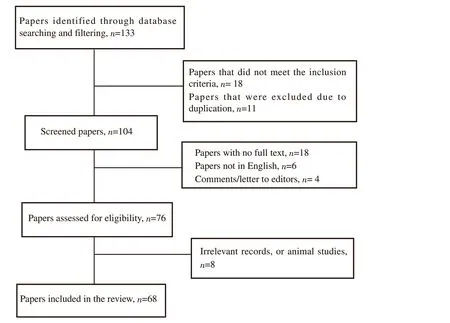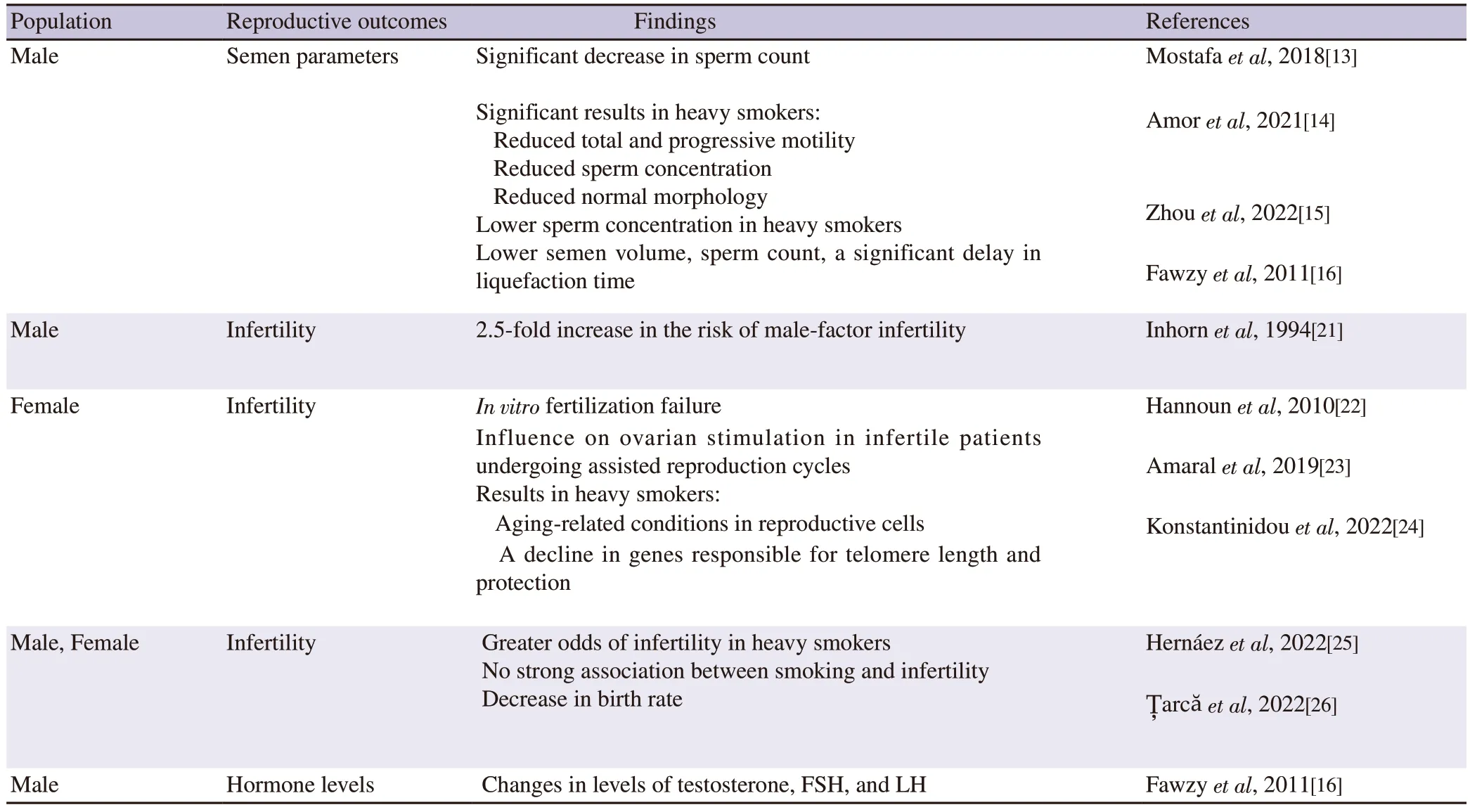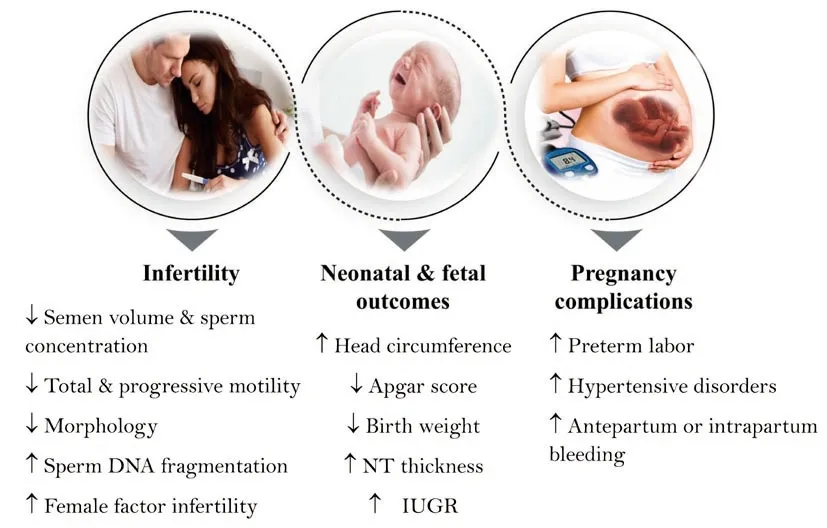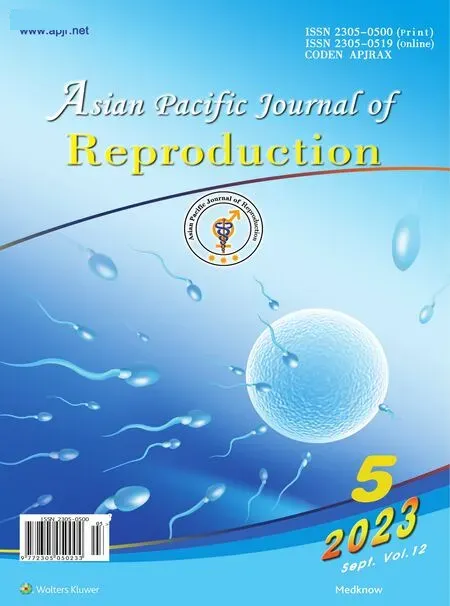Reproductive outcomes of water pipe smoking: A scoping review
Sahar Rostami ,Farzane Fereidouni ,Arezoo Maleki-Hajiagha ,Mohadese Motaharinejad ,Somayye Majidi ,Fardin Amidi✉
1Department of Anatomy,School of Medicine,Tehran University of Medical Sciences,Tehran,Iran
2Student Research Committee,School of Nursing and Midwifery,Shahrood University of Medical Sciences,Shahrood,Iran
3Department of Economics,Applied Statistics,and International Business,New Mexico State University,Las Cruces,NM,United States
ABSTRACT Objective:To present an overview of the adverse effects of water pipe smoking on various aspects of reproduction and perinatal complications,covering all the most relevant studies,from descriptive findings to clinical trials.Methods:We reviewed the literature and included full publications in English provided by international biomedical databases,including PubMed,Science Direct,EBSCO,Scopus,and Google Scholar,and Cochrane Library over the last 38 years (May 1985 to June 2023).Search terms (Water pipe,Narghile,Shisha,Dokha,etc.,and Reproduction,Fertility,etc.) were adopted from Medical Subheading (MeSH) and Boolean operators were utilized to improve sensitivity.Results:133 Papers were identified in the initial search,of which 29 were excluded due to duplication.Eliminating search overlap and irrelevant records by reviewing titles and abstracts reduced 42 papers.62 Full-publication articles met the inclusion criteria.We summarized the effects of waterpipe smoke exposure on reproductive health based on three main categories: male and female fertility,fetal and neonatal outcomes,and pregnancy complications.Conclusions:Water pipe smoking has potential adverse effects on different aspects of human reproductive health,including semen parameters,male and female fertility,and fetal and neonatal health,and contributes to many maternal complications and morbidities.
KEYWORDS: Water-pipe smoking;Tobacco;Fertility;Reproduction;Pregnancy
1.Introduction
Water pipe smoking,also called hookah,narghile,shisha,and hubble bubble in different cultures,is a form of smoking that uses flavored tobacco that is more aromatic than a regular cigarette.The tobacco in water pipe smoking should be exposed to the hightempered heat rising from burning charcoal to produce smoke.It has been revealed that this smoke is even more toxic than cigarette smoke[1].
According to the studies investigating the social aspects of water pipe smoking,social gatherings,pleasure,relaxation,and entertainment are the most prevalent motivating reasons reported by water pipe tobacco smokers.Results of a systematic review showed that the highest rates of prevalence are among adults residing in the Eastern Mediterranean and youth living in the Eastern Mediterranean and European region.Among the surveyed populations,Lebanese youth had the highest prevalence rates of both past 30-day and ever use,while Iranian university students had the highest prevalence of regular or occasional use.Egyptian youth had the highest frequency of daily use.Trend data showed that past-30-day use had increased over time among American youth (at a rate of 0.3%-1.0% per year) and Jordanian youth (at a rate of 2.9%per year).Comparable results were found for trends in ever use.Nevertheless,data from certain countries,such as Turkey and Iraq,indicated a decline in water pipe smoking[2].
The rising trend of water pipe smoking can be attributed to a common misconception that the water used in the device filters out harmful substances in the tobacco.Many individuals believe that water pipe smoking is less damaging to health than cigarette smoking.These perceptions have led to greater acceptance of water pipe smoking,particularly among women in Middle Eastern cultures,where cigarette smoking is generally deemed inappropriate for women[3].However,the reality is that water pipe smokers are not only exposed to fewer toxic compounds than cigarette smokers,but also inhale a larger volume of smoke in a single session,leading to higher levels of nicotine,carbon monoxide,tar,heavy metals,and carcinogens[4].Sharing water pipe mouthpieces can also result in the transmission of infectious agents.Moreover,exposure to water pipe smoke can increase the risk of respiratory disorders in passive smokers[5].
The question now arises: how will water pipe smoking,with its intricate social,personal,and health dimensions,impact the reproductive health of society? Investing more resources in reproductive function,both in terms of physiology and behavior,at different stages of life (beginning from the embryonic stage and lasting into adulthood and future generations) has a profound impact on the likelihood of developing numerous diseases and,ultimately,on overall lifespan[6].Epidemiological research shows that several aspects of lifestyle can affect reproductive health.One such aspect is nicotine consumption and its potential negative effects on fertility and reproductive function.
The evidence is mounting that smoking is linked to a higher risk of congenital heart defects,limb malformations,and central nervous system abnormalities[7].In pregnancy,water pipe smoking can hinder fetal growth,ultimately resulting in reduced anthropometric measurements in infants[8] and low birth weight[9].Given the various effects of water pipe smoking on reproductive health,this review seeks to examine its impact on human reproduction.
2.Methods
This literature review covers full publications in English in international biomedical databases,including PubMed,Science Direct,EBSCO,Scopus,and Google Scholar,and Cochrane Library from May 1985 to June 2023.Boolean operators (OR,AND) were used to create combinations of relevant keywords (i.e.Water Pipe OR Waterpipe OR Water-pipe OR Narghile OR Narghiles OR Nargile OR Nargileh OR Arghile OR Shisha OR Shishas OR Sheesha OR Sheeshas OR Chicha OR Dokha OR Dokhas OR Hookah OR Hookahs OR Hooka OR Hookas OR Hukka OR Hubble Bubble OR Hubble-bubble OR Qalyan OR Kalian OR Goza OR Boory OR Tobacco) AND (Reproduction OR Reproductive OR Female Fertility OR Male Fertility OR Fertilization OR Infertility OR Pregnancy OR Pregnant OR Ovulation OR Ovary OR Ovarian OR Menstrual Cycle OR Menopause OR Premature Ovarian Failure OR Premature Ovarian Insufficiency).
We conducted a quality appraisal of the included studies by defining inclusion criteria,study design (clinical trials,library reviews,case studies/series,and other descriptive studies),publication date,and language.We screened the titles and abstracts of the identified studies to determine their relevance to our research question and inclusion criteria.Studies that clearly did not meet the criteria were excluded.We obtained,thoroughly evaluated the full texts of the included studies,and assessed their quality,relevance,and suitability for inclusion in the scoping review.The Scoping Reviews (PRISMAScR) Checklist was used to make quality appraisal.
3.Results
3.1.Selection of sources of evidence
The initial search yielded a total of 133 papers,with 29 being excluded because of not meeting inclusion criteria or due to duplication.Papers with no full text,not in English,and comments/letter to editors were removed as well.Eliminating irrelevant records or animal studies by reviewing titles and abstracts reduced the number of papers to 68,which met the inclusion criteria (Figure 1).Key findings are presented under the following main headings:reproductive system,fetal and neonatal effects,and maternal harms.
Drawing on the review's findings,we have categorized the effects of water pipe smoke exposure on reproductive health into three main areas: male and female fertility,fetal and neonatal mortality and morbidity,and pregnancy complications.
3.2.Male and female fertility
3.2.1.Semen parameters
Overall,water pipe smoking may be associated with decreased fertility as it adversely affects semen volume,sperm count,and motility.Evidence suggests that water pipe smoking increases oxidative stress levels in the testis,leading to high sperm DNA fragmentation and abnormal cell morphology,along with a significant reduction in serum testosterone concentration,sperm count,and progressive motility[10-12].Heavy water pipe smokers have lower sperm concentration compared to non-smokers,with a noticeable difference seen between light smokers and non-smokers.Water pipe smoke has more toxic effects than cigarette smoke on sperm motility,and it is associated with lower semen volume,sperm count,and normal morphology,as well as a significant delay in liquefaction time[13].Another study has shown that heavy smokers experience a significant decrease in total and progressive sperm motility,sperm concentration,and normal sperm shape[14].Heavy smokers who smoke more than 20 cigarettes a day have been found to have lower sperm concentration compared to non-smokers.However,there was no significant difference between the sperm concentration of light smokers and non-smokers.Additionally,smoking status can be considered as a predictive marker for semen volume[15].Research has revealed that waterpipe smoke has a greater toxic effect on sperm motility compared to cigarette smoke.Waterpipe smoking has been shown to have harmful effects on semen parameters,resulting in lower semen volume,sperm count,and sperm with normal morphology.Furthermore,it causes a significant delay in liquefaction time[16].The impact of lifestyle factors,such as smoking frequency and body mass index (BMI),has been also investigated on male infertility.However,the analysis revealed no correlation between smoking frequency and sperm parameters such as number,motility,and morphology[17].Furthermore,chronic water pipe smoking has been found to have a significant impact on reproductive hormone and semen parameters in varicocele patients[18].Laqqan et al[19] discovered a significant increase in global DNA methylation,protamine deficiency,and DNA fragmentation in individuals who smoke waterpipes.Water pipe smokers were found to have significantly higher rates of DNA fragmentation,protamine deficiency,abnormal chromatin condensation,and elevated levels of 3,4-methylenedioxyamphetamine (MDA) in their spermatozoa[20].

Figure 1.Flowchart of the study screening process.
3.2.2.Infertility Exposure to water pipe smoking causes infertility in both males and females.An Egyptian case-control study reported that regular water pipe smoking is a significant risk factor for male-factor infertility.Regular water pipe smokers are found to be at 2.5 times greater risk of male factor infertility than nonsmoker men (after controlling for cigarette smoking)[21].One prospective Lebanese study suggested that exclusive water pipe smoking may be associated with in vitro fertilization failure[22].A study showed that tobacco influences ovarian stimulation in assisted reproduction cycles in infertile patients[23].A pilot study detected aging-related conditions in human reproductive cells and a decreasing pattern for genes involved in telomere length and protection in female heavy smokers compared to light smokers[24].Greater odds of infertility have been reported in heavy smokers of both genders.However,a strong association between smoking and infertility was not detected[25].Another research study that was trying to evaluate the impact of socioeconomic factors and crude birth rate,detected a negative correlation between birth rate and daily tobacco consumption[26].
3.2.3.Hormone levels
Water pipe smoking affects the levels of various reproductive hormones,such as testosterone,follicle-stimulating hormone (FSH),luteinizing hormone (LH),and leptin[16].It has been shown to affect the levels of testosterone,FSH,and LH,but not anti-Mullerian hormone levels or menstrual cycle regularity[27].Table 1 summarizes the effects of water pipe use on male and female fertility.
3.3.Fetal and neonatal mortality and morbidity
3.3.1.Prenatal screening tests In addition to the increased risk of congenital malformations,water pipe smoking can also affect the results of first-trimester screening tests by altering biomarkers of trisomy 21.One study found that water pipe smoking significantly decreases the levels of β-hCG and PAPP-A,while slightly increasing the fetal nuchal translucency (NT)thickness[28].
3.3.2.Growth and birth weight
The findings on the relationship between water pipe smoking and birth weight are inconsistent.Some studies have shown that exposure to water pipe smoking can reduce birth weight[29-36],while others have found no significant association between water pipe smoking and increased risk of low birth weight[30,31,34,37-41].A population-based study conducted in Southern Iran among rural pregnant women found that mothers who began smoking during the first trimester had more newborns with low birth weight compared to those who started smoking in the second or third trimester[42].Another study investigating the effect of maternal smoking during pregnancy on newborn anthropometric measurements reported that water pipe smoking during pregnancy can lead to a reduction in these measurements[8].However,a cohort study analyzing the possible effects of paternal smoking on neonatal outcomes found no association between paternal smoking and lower birth weight[43].

Table 1.The effects of water pipe smoking on male and female reproductive outcomes.
3.3.3.Head circumference
A study examining the effects of tobacco cessation during pregnancy on birth anthropometric measures found that water pipe smoking during pregnancy leads to an increase in head circumference at birth compared to quitting smoking during pregnancy[35].
3.3.4.Preterm birth The findings regarding the relationship between water pipe smoking and preterm birth are inconsistent.Studies have shown that women who smoke water pipe during pregnancy are at an increased risk of preterm labor[31],and there is evidence suggesting an association between smokeless tobacco use and preterm birth[44].However,a historical retrospective cohort study conducted in Lebanon[29]found no association between water pipe use and an increased risk of preterm delivery.Similarly,a cohort study[43] did not find any association between paternal smoking and preterm delivery.
3.3.5.Apgar score Women who are exposed to tobacco smoke,whether actively or passively,during pregnancy (especially during the first trimester),are at an increased risk of having a lower Apgar score for their newborns and fetal respiratory distress.This risk applies to both cigarette and water pipe smoke exposure[29-31].
3.3.6.Fetal tobacco syndrome
Exposure to tobacco during pregnancy can cause fetal tobacco syndrome,also known as fetal nicotine syndrome,which can lead to various complications such as low birth weight,premature birth,stillbirth,and sudden infant death syndrome (SIDS).This syndrome has been reported in studies examining the effects of tobacco exposure during pregnancy[31,45,46].
3.3.7.Neonatal complications
Exposure to tobacco,whether through active or passive smoking of cigarettes or waterpipes,during pregnancy can pose risks to the child's health and development.These risks include difficulty in breathing[29],respiratory diseases[30,31,47],perinatal mortality[44],medical complications in babies[30],infant mortality[48],pediatric asthma[49],developmental delays,growth retardations in children[50],infantile colic,bone fractures,and childhood obesity[33].The effects of waterpipe use on fetal and neonatal mortality and morbidity are summarized in Table 2.

Table 2.The effects of water pipe smoking on fetal and neonatal mortality and morbidity.

Table 3.The effects of water pipe smoking on maternal mortality and morbidity.

Figure 2.The effects of water pipe smoke exposure on male and female fertility,fetal and neonatal mortality and morbidity,and pregnancy complications.NT:nuchal translucency;IUGR: intrauterine growth retardation.
3.4.Pregnancy complications
Pregnant women who are exposed to tobacco products,including nicotine smoking,are at an increased risk for perinatal mortality[51,52]and morbidity[52-56].The maternal and fetal side effects of tobacco and nicotine smoking during pregnancy include ectopic pregnancy and decreased maternal thyroid function[33].A historical retrospective cohort study conducted in Lebanon found that water pipe smokers had an increased risk of antepartum or intrapartum bleeding and hypertensive disorders of pregnancy compared to non-smokers[29].Water pipe smoking has also been linked to premature menopause,osteoporosis,and cervical cancer[57].Table 3 summarizes the effects of water pipe smoking on pregnancy complications.
In all,the effects of water pipe smoke exposure on three main areas of reproductive health: male and female fertility,fetal and neonatal mortality and morbidity,and pregnancy complications are shown in Figure 2.
4.Discussion
We reviewed the effects of water pipe smoking on three different categories of reproductive outcomes (reproductive system,fetal,and neonatal mother).The findings from this review highlight the adverse effects of water pipe smoking on fertility,fetal and neonatal mortality and morbidity,and pregnancy complications.The findings suggest that water pipe smoking has a detrimental impact on semen parameters,such as semen volume,sperm count,and motility,leading to male-factor infertility.The toxic effects of water pipe smoke on sperm motility are also higher than those of cigarette smoke,indicating that water pipe smoking is particularly harmful to male fertility[58].Some effects of water pipe smoking on ovarian function include a higher FSH level,a lower mean number of retrieved oocytes,and a higher miscarriage rate[59].
This review showed that exposure to water pipe smoke affects fetus and neonate health parameters,including birth weight,head circumference,and Apgar score,and is associated with increased risk of preterm birth,abortion,intrauterine growth retardation(IUGR),malformations,and fetal tobacco syndrome.The positive correlation of water pipe smoking with low birth weight,IUGR,and low Apgar score could be related to the sympathomimetic activity of cathinone,the active ingredient of water pipe smoking that has potential vasoconstrictive activity[60].Carbon monoxide exposure also can increase the risk of IUGR[61].The vasoconstrictive activity of ingredients of waterpipe smoke led to reduced placental blood flow,hypoxia,and consequently IUGR.The results also suggest that pregnant women who smoke water pipes are at an increased risk of pregnancy complications,such as antepartum or intrapartum bleeding and hypertensive disorders of pregnancy.Water pipe smoking has also been linked to premature menopause,osteoporosis,and cervical cancer.
Overall,the findings presented in the text emphasize the harmful effects of water pipe smoking on fertility,fetal and neonatal mortality and morbidity,and pregnancy complications.These findings have important implications for public health,highlighting the need for targeted interventions and policies to reduce the prevalence of water pipe smoking.Further research is needed to better understand the mechanisms underlying the adverse effects of water pipe smoking on reproductive and maternal health and to develop effective prevention and intervention strategies.Different mechanisms are proposed to clarify the teratogenic effects of water pipe smoking,including:1) increased oxidative stress;2) gene expression alterations;3)abnormal glucose,protein,lipid,and DNA metabolism;and 4)endocrine disturbances[62].
The adverse effects of water pipe smoking on reproductive health highlight the urgent need for effective prevention and intervention strategies[63].One approach to preventing water pipe smoking is through education and awareness campaigns.These campaigns can educate individuals about the health risks of water pipe smoking and promote healthy lifestyle choices[64].Additionally,policymakers can implement regulations that restrict the use of water pipes in public places and increase taxes on water pipe tobacco products,similar to cigarette taxes,to discourage their use[65].
Another approach is to provide smoking cessation programs that specifically target water pipe smokers.These programs can include behavioral therapies,nicotine replacement therapies,and other pharmacological interventions that have been shown to be effective in helping individuals quit smoking.Additionally,healthcare providers can play a crucial role in promoting smoking cessation by providing counseling and support to individuals who smoke water pipes[66].
Finally,it is important to understand the cultural and social factors that contribute to the prevalence of water pipe smoking.Addressing these factors,such as social norms and peer pressure,can help to reduce the prevalence of water pipe smoking in certain populations.Interventions that take into account cultural and social factors may be more effective in reducing the prevalence of water pipe smoking in these populations[67].
Preventing water pipe smoking requires a multi-faceted approach that includes education and awareness campaigns,smoking cessation programs,policy interventions,and addressing cultural and social factors.By implementing these strategies,we can help to reduce the prevalence of water pipe smoking and prevent the adverse effects on reproductive health[68].
There are some limitations in the study.We did not use a systematic approach to identify,select,and evaluate studies in this review.Further systematic reviews and meta-analyses that focus on clinical studies are necessary to produce comprehensive and high-quality reports.
In conclusion,water pipe smoking has potential adverse effects on different aspects of human reproductive health,including semen parameters,male and female fertility,and fetal and neonatal health,and contributes to many maternal complications and morbidities.However,few studies exclusively focused on the reproductive hazards of water pipe smoking.Systematic reviews and metaanalyses are warranted to investigate the effects of water pipe smoking on the female and male reproductive systems.
Conflict of interest statement
The authors declare no conflicts of interest.
AcknowledgementsWe would like to express our sincere gratitude to the peer-reviewers who provided valuable feedback on this manuscript.
Funding
This study received no extramural funding.
Authors’ contributions
Sahar Rostami contributed to the conceptualization,study design,and wrote the first draft.Sahar Rostami,Farzane Fereidouni,Arezoo Maleki-Hajiagha,Mohadese Motaharinejad,and Somayye Majidi collected the data.Sahar Rostami and Somayye Majidi interpreted the data.Arezoo Maleki-Hajiagha paraphrased and proofread the manuscript.Fardin Amidi supervised the data collection and analysis,interpreted the results,and drafted the manuscript.All authors agreed on the final version of the manuscript.
 Asian Pacific Journal of Reproduction2023年5期
Asian Pacific Journal of Reproduction2023年5期
- Asian Pacific Journal of Reproduction的其它文章
- Effect of taxifolin on cold-shock damages in spermatozoa in rabbits
- Methanolic pomegranate dried peel extract improves cryopreserved semen quality and antioxidant capacity of rams
- Predictors of antenatal health service utilization among left-behind wives of male outmigrants: Evidence from Patna District,India
- The role of small non-coding RNAs (sncRNAs) in male infertility: A scoping review
